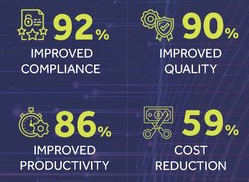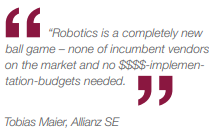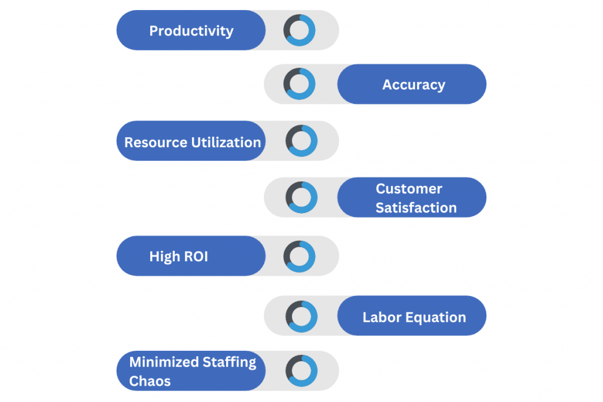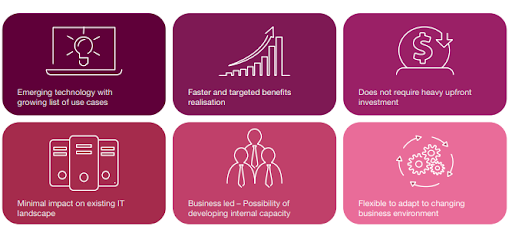RPA Benefits vs Cost of Integration - Deciphered!
Discover the benefits of Robotic Process Automation (RPA) for businesses: increased productivity, accuracy, resource utilization, customer satisfaction, and high ROI. Learn about factors influencing RPA cost.

According to the annual work index, employees spend 58% of their day doing "work about work," including communicating about work, searching for information, swapping between different apps, and so on.
This costs the service industry in 11 countries more than 5 trillion (yes, it's a "T") annually. Because of this, businesses from different sectors and verticals consider shedding the burden of mundane and rule-based tasks off your employee's shoulders as a good idea.
Robotic Process Automation (RPA) has gained significant attention in recent years for its ability to automate repetitive tasks and enhance operational efficiency.
After all, the benefits of integrating RPA are phenomenal, have a look at what even a recent Deloitte study has confirmed!

Unquestionably, these whopping numbers help promote RPA as the next BIG thing the business world has been seeking. However, all that is gold does not glitter.
Why Is It Any Different Now?
Automation is different now because of solutions like Robotic Process Automation (RPA).
RPA has become exceptionally viable for small and medium-sized businesses owing to numerous factors - importantly cost and availability.
Earlier, RPA was considered an initiative that was out of reach for an SMB, but today it’s easily integrated, deployed, and scaled. Moreover, businesses across the globe are seeing RPA benefits as a standout competitive advantage in terms of improving their efficiency and effectiveness in how they leverage data.
Evaluating The Cost of Automation - An In-Depth Analysis
You must be wondering - “What are the crucial factors behind the presumably high robotic process automation cost”? Or, what should your organization do to realize the complete potential of RPA without breaking the bank?

One-time Costs for the RPA Implementation Process:
- Consulting
- Opportunity assessment
- Framework Design
- Process Development
- Testing
- RPA Deployment
Consulting: RPA consulting costs involve engaging with experts or consulting firms for assessing feasibility, strategizing, and implementing successful automation within your organization.
Opportunity assessment:
Let’s discover!
Top Five Factors Driving RPA Cost
- RPA vendor pricing models
- Number and complexity of bots in your RPA deployment
- Process analysis, RPA consulting, and engineering costs
- The cost of RPA integration
- Maintenance, support, and RPA scaling costs
Here’s a comprehensive overview of these factors. Let’s have a look.
1. RPA Vendor Pricing
Gartner's 2022 Magic Quadrant Report for Robotic Process Automation and Forrester Wave: Robotic Process Automation, Q1 2021 survey, UiPath, Automation Anywhere, and Microsoft Power Automate are the driving forces of the global RPA market, predicted to reach $50.50 billion by 2030.
Let’s see how UiPath - a leading RPA vendor pricing model - stacks up against other pricing models to evaluate the RPA cost of integration.
UiPath:
UiPath offers a range of pricing plans to cater to different automation needs. The Automation Developer License is priced at $420 per month, providing users with the necessary tools to develop and deploy automation processes. For businesses requiring unattended automation, the Unattended Automation plan is available at $1,380 per month, enabling the execution of automated tasks without human intervention. The Automation Team plan, priced at $1,930 per month, offers comprehensive automation capabilities for teams and larger organizations.
UiPath supports multiple platforms, including desktop (Windows and Mac) and mobile (Android and iOS), ensuring flexibility and accessibility across devices.
To help users get started, UiPath provides a free 60-day trial period. Additionally, the AI Center, a key component of UiPath's platform, offers its own free trial, allowing users to explore its advanced cognitive capabilities. There is also a community edition available, providing access to a vibrant user community and resources for learning and collaboration.
With its AI Center, UiPath enhances automation capabilities by leveraging artificial intelligence for tasks such as data extraction and analysis, further improving the efficiency and effectiveness of automated processes.
UiPath's pricing options, platform support, free trial offerings, and cognitive capabilities make it a compelling choice for businesses seeking a comprehensive RPA solution.
Automation Anywhere:
Automation Anywhere offers flexible pricing options for their RPA solutions. While specific pricing details are available upon request, their fees start from $750 per month for the Cloud Starter Pack. Additionally, for businesses requiring additional attended or unattended bots, there is an additional cost of $125 or $500 per bot per month, respectively.
Automation Anywhere's platform is compatible with desktop operating systems such as Windows, as well as mobile platforms including Android and iOS, ensuring accessibility across devices.
To help users explore and experience the capabilities of their RPA platform, Automation Anywhere provides a fully supported 30-day trial, allowing organizations to evaluate its features and functionalities.
Automation Anywhere's offerings also include IQ Bot and Bot Insight, which provide advanced cognitive capabilities and insights into automation processes, respectively. These features enhance automation capabilities by incorporating artificial intelligence and providing valuable analytics.
With its range of pricing options, platform compatibility, trial period, and cognitive capabilities, Automation Anywhere offers a comprehensive RPA solution for businesses in various industries.
Microsoft Power Automate:
Microsoft Power Automate provides a range of plans to cater to individual users and companies seeking RPA solutions. These plans offer different features and capabilities based on specific requirements:
Presently, Microsoft offers three plans for individual users and companies looking for RPA:
-
$15* per-user plan: This plan is designed to help users analyze processes and create cloud flows tailored to their unique business needs. It provides the necessary tools and functionalities to automate workflows efficiently.
-
$40/user plan: In addition to the starter's pack, this plan enables companies to automate legacy applications using RPA and AI technologies. It offers enhanced capabilities to streamline and optimize business processes.
-
$500 enterprise RPA plan: Geared towards larger organizations, this plan provides five fully automated flows and supports an unlimited number of users. It offers comprehensive automation capabilities to drive efficiency and productivity at an enterprise level.
Microsoft Power Automate is compatible with desktop systems running Windows, ensuring seamless integration with existing infrastructure.
To facilitate evaluation and adoption, Microsoft offers a 30-day free trial period for users to explore the features and benefits of Power Automate firsthand.
With its diverse plan options, desktop compatibility, and trial period, Microsoft Power Automate empowers businesses to automate their workflows and enhance productivity through streamlined processes.
Comparison of RPA Vendor Pricing: UiPath, Automation Anywhere, and Microsoft Power Automate:
| Features | UiPath | Automation Anywhere | Microsoft Power Automate |
|---|---|---|---|
| Pricing | Automation Developer License: $420/month | Fees start from $750/month (Cloud Starter Pack) | $15* per-user plan, $40/user plan, $500 enterprise RPA plan |
| Unattended Automation | $1,380/month | Additional cost per bot ($500/month) | Included in the enterprise plan |
| Platform Support | Desktop: Windows, Mac | Desktop: Windows, Mobile: Android, iOS | Desktop: Windows |
| Free Trial | Free 60-day trial | Fully supported 30-day trial | 30-day free trial |
| Cognitive Capabilities | AI Center | IQ Bot and Bot Insight | N/A |
* Note: The pricing information mentioned above is subject to change and may vary based on specific requirements and negotiations with the respective vendors.
Considering the whopping numbers, numerous technology companies are stepping into the RPA market, offering tools and development platforms at subscription models.
An RPA vendor pricing model and software deployment approach mostly determine an RPA license's cost. For example, cloud-based RPA tools might cost less if bundled, whereas an on-premises deployment can be cheaper if you want a long-term commitment.
Typically, RPA vendor licensing fees account for 30% of total robotic process automation costs - or ⅓ of an average salary of a full-time employee performing tasks manually.
2. Number and Complexity of RPA Bots
Robotics Process Automation tools are different.
For example, there are two types of bots - attended and unattended RPA bots. The core difference between these two types of intelligent software bots lies in their ability to perform tasks independently.
Also, not to forget it’s quintessential to mark the difference between business process automation and robotic process automation tools.
Business Process Automation (BPA) follows the if-then pattern to automate workflows, whereas RPA watches your employees interact with software system interfaces and mimic their actions. Therefore, it’s right to say BPA and RPA have a brighter, more technologically upgraded relative, coined as Intelligent Process Automation (IPA).
IPA systems feature machine learning algorithms that extract and analyze unstructured data in disguise of enterprise IT systems.
The number of bots in RPA development, their cognitive abilities, and the workload they manage are listed among the crucial RPA cost drivers.
3. Process Analysis, RPA Consulting, and Engineering Costs
Despite technological advancements, RPA tools don’t require brand-new platforms and significant infrastructure upgrades.
However, RPA requires a good upfront design and deep expertise in the processes subjected to automation. Otherwise, your RPA deployment will have configuration errors, which could end bots sourcing information from IT systems and performing tasks efficiently.
This is why companies eyeing robotic process automation turn to experienced RPA development companies. But, before you choose a reliable development partner, ensure your technological partner is a certified UiPath or Automation Anywhere partner. Or a budding technology that nevertheless employs skilled robotic process automation engineers.
The RPA company you choose will thoroughly review your processes, identify appropriate strategies for automation, and recommend the right technology stack. Furthermore, your technology partner will devise a high-level RPA architecture and integration roadmap.
Trusted RPA vendors also choose an iterative, result-driven approach to automation, creating proof-of-concept versions of intelligent software agents, training them to perform tasks, optimizing their performance, and putting up robust data visualization and reporting tools that make RPA accessible to everyone.
Eventually, this approach helps companies get started with RPA risk-free, achieve ROI quicker, and save exponentially on automation spending.

A Note: RPA consultants and developers hourly rate vary from $15 to $60, depending on the country the vendor resides.
4. Cost of RPA Integrations
RPA tools must be connected to the systems over APIs to access IT systems and their interfaces. And, it’s not a surprise, the cost of all the APIs, applications, and services that contribute to the complete robotic process automation costs - not all those APIs are provided or supported by your RPA service provider by default.
So, connecting your bot to AWS, Azure, or Google Cloud services, for instance, would add additional robotic process automation costs that increase proportionally with the amount of data and server calls managed by the bot.
In totality, add-on tools account for approximately 5% of the entire RPA costs.
5. Maintenance, support, and RPA scaling costs
Since RPA bots reside in and engage with current software applications, significant changes made to these systems or the data they produce may trigger RPA reconfigurations and frequent updates too.
Simultaneously, many companies overlook RPA scaling costs or fall victim to scope creep, expanding automation efforts to as many processes and business verticals as possible or trying hands-on the idea of adding AI capabilities to existing RPA systems.
One way to avoid these challenges is to build a high-level RPA implementation strategy at the initial stage. So, this approach, among other things, accommodates software dependencies, proactive change management, and stakeholder alignment.
Ultimately, the key to evaluating RPA success is understanding that RPA is not a silver bullet. Rather, RPA is a cog in the wheel of your business, and when appropriately oiled, it can turn far more efficiently.
Do RPA Benefits Surpass The Total Cost Of Project Ownership?
Simply put, “the upsides of Robotic Process Automation are quickly outweighing the negatives from a cost-effectiveness viewpoint”.
The Key Benefits RPA Offers to Businesses
There’s no doubt that RPA benefits are wide-ranging and far-reaching.
RPA has the potential to significantly improve business operations by allowing you to focus on customer satisfaction and employee engagement through process speed, accuracy, and cost efficiency.
The non-exhaustive list of the RPA benefits includes:

-
Productivity
Compared to humans, bots can complete the same tasks approximately five times faster. Besides, they work 24/7. This implies work will be done faster, which creates the capacity for more work to get done.
Considering business-specific processes, RPA helps automate the majority of operations and reduce human work as follows:
- Data transfer from one source to another
- Updating databases and presenting apps
- Extracting data from files
- Managing communication tools like instant messaging and email
- Standardizing processes and decision-making with Machine assistance
- Tracking applications
Overall, higher productivity is inversely proportional to expenses and makes room for growth.
-
Accuracy
Human errors often pave the way to poor decision-making and expensive operational mistakes. Studies show that human-related factors cause a mammoth of 80% of maintenance errors.
Here, Robotic Process Automation introduces a high level of business precision that eliminates human errors. This trusted technology is consistent and improves the quality of the output. A handful of the errors it eliminates are:
- Incorrect or missing customer information
- Data insecurity
- Customized data and false analytics
Though any data errors could interfere with your customer’s experience, with RPA the chances get minimal. Also, it optimizes operations and completes mundane tasks quickly without compromising on the quality of work done.
-
Resource Utilization
One of the biggest challenges for businesses is operational efficiency.
This is the inability to identify the underperforming resources and the bottlenecks employees encounter in their daily to-do lists. A study presented that 92% of employees are more efficient when they are assisted by technology for their daily tasks. In simpler terms, RPA eliminates expensive operational mistakes by motivating the workforce and enhancing decision-making.
RPA takes over monotonous tasks and makes them bug-free, enabling your employees to focus on tasks that matter. It’s also versatile enough to perform an exquisite array of tasks, minimizing the number of resources channelled toward them.
-
Customer Satisfaction
A HubSpot study showed that more than 90% of satisfied customers are likely to repeat purchases, especially when the company has excellent customer service.
So, by shedding the onus from your customer-service personnel from tabulations and forms, you are giving them ample space to offer bespoke customer service. Often, the result is an improved customer experience with great potential to meet the requirements of service-level agreements.

-
High Return On Investment (ROI)
High operational costs can be a bottleneck in your ROI. But, integrating RPA into your daily processes can reduce your operational cost by up to 50%; this implies operating costs generally drop quickly.
Moreover, bots work 24 hours, seven days a week, 365 days a year without taking a break - this means a continuous workflow! So, adopting RPA technology ensures that your operations work continuously and save your resources that would have else been used to hire more employees.
Some IT expenditures can make you wait months or years before ROI shows up, but with RPA, you’ll begin seeing ROI in weeks.
-
Change in Labor Equation
Unquestionably, RPA changes your labor equations - but that doesn’t importantly mean you’ll be slashing Full-Time Equivalents (FTE). As a result, your human workforce will be freed from monotonous routines and mundane tasks for which they are overqualified.
So, that eventually leaves them the bandwidth to manage higher-value work.
-
Minimized Staffing Chaos
There’s nothing straightforward about staffing, especially in some teams of your organization where the demand is uneven, activity levels are unpredictable, and the turnover is high. However, bots can quickly scale up and down, unlike the human workforce.
Besides, they can be deployed quickly and much more cost-effectively. So, it’s fair to say that with RPA, it’s much easier to have the right staff level at the right time.
Finally, How much does Robotic Process Automation (RPA) really Cost?
Let’s find it!
Making a business plan for Robotic Process Automation sounds easy - businesses can easily see the value of shifting mundane, labor-intensive, repetitive tasks from humans to bots. After all, the key benefits of integrating RPA are phenomenal; have a look at what even a recent Deloitte study has confirmed!
The mind-boggling stats mentioned in the above post portray that RPA benefits outweigh the cost integration part.
Rising costs and underwhelming ROI are primary motivators driving RPA platform migrations as automation programs look for better returns elsewhere.
RPA is revolutionizing process efficiencies and maximizing productivity across companies, and it’s rewriting the way conventional businesses and models work. Even in some scenarios, analysts recommend that RPA create a second parallel economy that bridges to the physical economy in concurrent systems to speed up and optimize knowledge work.
Justifying the costs of automation may seem daunting, but investing in the technology and its long-term outcomes has been effective across industries in building an enterprise’s competitive advantage while keeping the business prepared for market changes. Positioning your business to outperform competitors is invaluable; the time to automate is now.
It’s high time to bring your business on board and be a part of the most significant change ever!
Frequently Asked Questions
Have a question in mind? We are here to answer.
What are the benefits of implementing RPA?
![]()
How does RPA reduce costs?
![]()
What is the cost of integrating RPA?
![]()
How do you measure the ROI for RPA implementation?
![]()
Are there risks or challenges with RPA integration?
![]()



.png?width=344&height=101&name=Mask%20group%20(5).png)






.webp?width=352&name=ezgif.com-gif-maker%20(32).webp)









